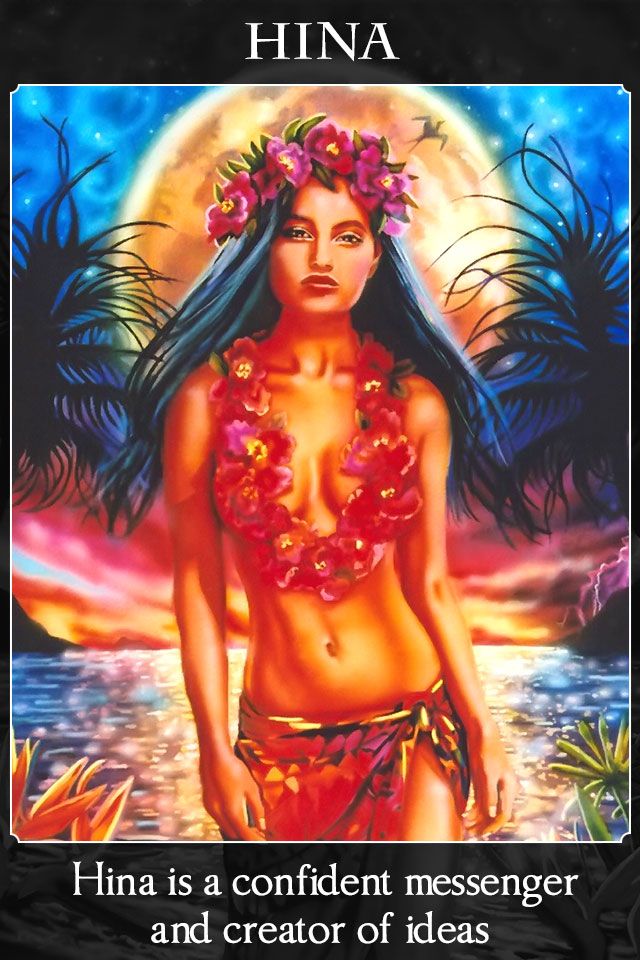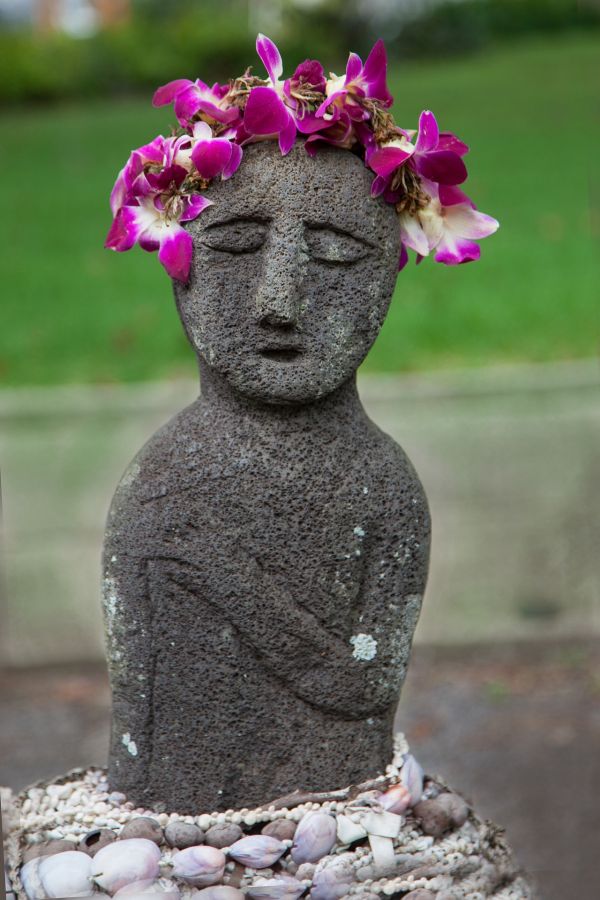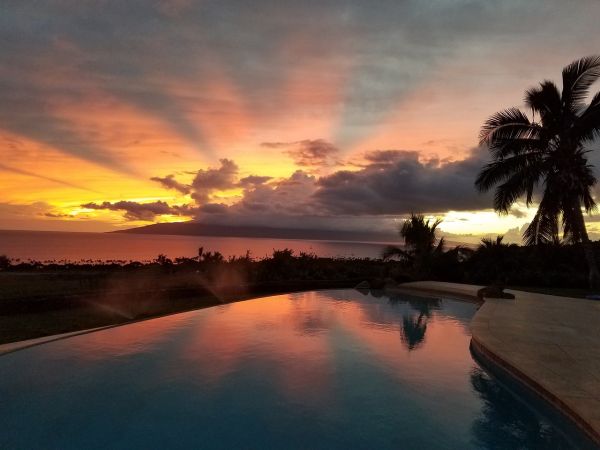The Goddess Hina - Reclaiming Home
- Details
- Written by Lisa Iris
- Views: 1674

May 2023
The Goddess Hina – Reclaiming Home
May 1st is Lei Day in Hawaii, conjuring visions of tourists heaped with garlands, greeted by “Aloha!” Once, the lei was an offering to the Gods, or bestowed as medicine. In contrast, Lei Day was invented in 1928 for publicity and profit by Don Blanding, an American writer with a military background. No doubt he had good intentions, but there’s a saying about such things paving a road to someplace unpleasant.

Comedy
Leis appear at the beginning of HBO’s social satire “The White Lotus” Season 1 (2021), as vacation ers, adorned with orchids, are welcomed by The White Lotus staff. The resort is Instagram perfect, but Nature foreshadows turbulence, as waves crash on the rocks. Over the course of a week, the once-smiling staff will become collateral damage, sacrificed to the guests’ privilege, neuroses and demands. Colonialism and Tourism are thirsty twins at the bar, and the cocktail du jour is Mayhem & Manslaughter. We watch and wonder; how long can a host serve, indeed survive, narcissistic guests protected by wealth, oblivious to the chaos they create?
Tragedy
This HBO series was filmed in Maui, where 70% of every dollar comes from tourism. Two years after its release, and only 41 miles from its location, tragedy struck.
On August 8th, 2024, the town of Lahaina was destroyed by wildfire. The former capital of the Kingdom of Hawaii, Lahaina was home to nearly 13,000 people. A flourishing community with businesses, cultural venues and muti-generational homes, Lahaina was deeply rooted in ancestral ground. In addition to the devastating loss of life, property damage, and destruction of cultural artifacts, there has been an ongoing outrage over a lack of accountability: for the fire’s circumstances, the horrifically mismanaged response, and the inadequate relief for homeless survivors.
This sequence of trauma, loss, bereavement, displacement - and a government/corporate/real estate collusion hovering in the background - is too terrible to bear. Unless, one lives for the sake of justice.

A Tree Grows in Lahaina
Though damaged, the town square’s great banyan tree survives, evinced by budding patches of green. This recalls a Hawaiian myth, of another bayan tree growing on the Moon: its leaves and branches casting shadows on the lunar surface. Sitting under this banyan is the Goddess Hina making Kapa, a cloth created from beaten bark. Hina also fled from her home, and found refuge on the Moon, where she watches all from above.
“The poverty cycle of stolen land” predates the incursion of tourist real estate, starting in 1778, when Captain Cook dropped anchor and brought Paradise to the world’s attention. Plantations were established in the 1800’s and trouble began in earnest with a coup d’etat led by Sanford Dole, representing American businesses, backed by the American military – opening the way for U.S. annexation in 1889.
The Hawaiian Sovereignty Movement, founded in the 1970’s, continues as a grassroots movement for natives to reclaim political autonomy. The “Hawaiian Renaissance” movement, also appearing in the 70’s, advocated self-reliance through revitalizing native culture. Today, the Maui Arts and Cultural Center partners with the Health Dept. to provide art therapy for Lahaina survivors with PTSD. One of the ancestral arts, revived by the Hawaiian Renaissance, is making Kapa.

Hina – When Aloha Means Goodbye
Hina is the primordial Wahine, the divine feminine rising from the sea. Also called Ina, Hine and Sina, the many variations of her myth span the archipelago’s eight islands. One theme that’s consistent is Hina making kapa, and sharing this skill with humans.
Hina married a mortal and made kapa from dawn to dusk, to support her family. Angry and exhausted by defiant children and a lazy husband, she climbed the nearest rainbow to visit the Moon. Hina returned to Earth to pack a few things, but this time, her husband chased after her. He dragged her down from the rainbow. Grabbing her foot, he broke it off and cruelly mocked her, as she could barely crawl. Undaunted, Hina struggled to climb, as benevolent spirits appeared to help carry her to the Moon.
Looking down from her new home, Hina attained a vast perspective: as would a goddess remembering her worth, a woman escaping abuse, or a people reclaiming their legacy.

Kapa – Past and Present
Kapa, the Goddess’ cloth, was once essential. It was used for clothing, ceremonial attire, bedding, banners, bandages, trade, gifts, wrappings for infants and shrouds for the departed. With the arrival of Europeans, kapa was replaced by imported cloth. European goods displaced native skills, and Indigenous culture was repressed. Hawaii’s native language was banned from schools, and speaking it at home was discouraged. Activities such as he’e nalu (wave sliding), and the hula, were censured by missionaries. Amazingly, polytheistic beliefs covertly endured.
Kapa artists, or “practitioners,” such as Dalani Tanahy of Oahu, were interviewed in Perspective’s 2018 “Handmade in the Pacific,” a British documentary series. Like Hina, Dalani shares this art, as outdoor Kapa classes attract men and women, as children play nearby.
Dalani describes the absence of written records for creating kapa and credits DNA for her trial-and-error re-creation of a lost art. Dalani experiences the time and labor-intensive work as “a kind of meditation.” “All my kapas are alive. They all have their purpose and story.” The completed cloth is painted with dyes from local berries, bark and squid ink. Dalani’s work is commissioned for special occasions, such as costumes for dancers interpreting ancient legends or paying tribute to Hawaii’s last sovereign, Queen Lili’oukalani (imprisoned and forced to abdicate by American business interests.)

Reclaiming Home
Long before Lahaina’s diaspora, Hawaii’s native population has been forced to move, being priced out of their homes. As Hawaii has “the nation’s highest rate of chronic homelessness,” it’s possible your hotel receptionist is living in her car, as two jobs doesn’t cover the rent. Since the fire, over 5,000 displaced Maui residents are being pressured to find jobs in tourism, without having sufficient time to grieve and honour Lahaina’s deceased.
Many hotels, despite accepting government support, turn disaster-affected tenants into transients, claiming rooms need to be rented to paying tourists. A notice slipped under the door can evict a family in three days. Despite FEMA’s and the Red Cross’ best efforts, how can tent communities (deemed unsafe for children), temporary rental units (which might not allow a beloved pet), or soulless mass-produced tiny houses, provide security with dignity?
In a perfect world, a native government and ethical eco-tourism could co-exist. Until then, the future of many is dictated by a few. Land grabs, water diversion and corporate incursion isn’t always news from abroad; it can happen where you are. When land is seized or destroyed and rights are swept aside, “Home” becomes personal sovereignty in lieu of political self-determination. Home is where love lives: expressed through language, values, teachings and traditions. Home is resistance and resilience; it is an integrity derived from ancestors, family, culture and activism.

Hina’s kapa is an emblem of such solidarity. Wood strips, laid side by side, expand when pounded. “The fibers have the memory to stay together,” connecting the bark sheets into a unified fabric. Until the Islands regain independence, and home is reclaimed, a community assembles in spirit, under Hina’s moonlight and the sheltering banyan tree.
About the Author:
Hina Artwork and this text is Copyright 2023 Lisa Iris. All Rights Reserved. Reprinted with written permission from Crystalwind.ca and Antonio DeLiberato Exclusive Worldwide agents for Hina by Lisa Iris.
Lisa Iris is an artist and proprietress of MYTHOS Art and Counselling 289 High St., Fort Erie, ON. Her artwork is represented exclusively by crystalwind.ca and is featured in The Crystal Wind Oracle by Antonio DeLiberato.
Lisa enjoys opening her home to kindred spirits for conversation and for making magic happen.
Get The Crystal Wind Oracle Here!
Posting on CrystalWind.ca ©2024. All rights reserved. Please do not reproduce any content without written permission. The article's title was crafted by CrystalWind.ca.
Liked this article? Dive deeper into personal growth and wellness! Check out CrystalWind.ca for spiritual wisdom or explore AromaWorx.ca for natural well-being tips. Spread the positivity—share this with friends on their happiness journey!
Let’s Chat! Drop Your Thoughts Below! ![]()
Latest Articles
Dive into the Mystical World of the Crystal Wind Oracle Deck!
Get All the Enchanting Details Now!
NEW Expanded Boxed Edition!
Now with 58 Cards for Richer Wisdom!

Imagine a world of inspiration and healing, free for all—made possible by YOU!
Donate Now—Ignite the Magic at CrystalWind.ca!

Epilepsy - Finding A Cure
Your donation can make a difference!
Help us find a cure – donate now!
Follow Us!
Featured This Month
Chalcedony
The Stone Of Orators Chalcedony was very popular as a decorative stone in ant... Read more
Cancer Mythology
The Mythology of Cancer: A Celestial Tale of Loyalty and Sacrifice Among th... Read more
Lugh - Celtic God Of The Sun
The god Lugh was worshiped in Ireland as a deity of the sun. This connection... Read more
Sun in Cancer
Cancer Sun Sign Characteristics Overview The name "Cancer" comes from Latin, ... Read more
Lammas by The Hedgewitch
Although in the heat of a Mid-western summer it might be difficult to discer... Read more
Abalone Shell
Echos Of The Ancestors Abalone strengthens the structure of the body and th... Read more
Egyptian Zodiac/Astrology
Egyptian astrology was one of the earliest forms of astrology. The Egyptians w... Read more













































